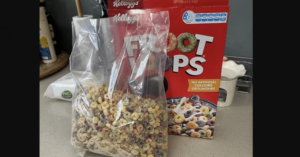
Sharing an image of the partially filled bag on Facebook, Renee’s post sparked dismay among hundreds of other shoppers who resonated with her frustration. “$10 for half a bag of Froot Loops – the world has gone mad,” she lamented.
Renee confessed that she had learned her lesson about the expensive purchase. “I’ll only buy it when it’s on special from now on because I’ll be lucky if the box lasts a week with my family of four,” she remarked.
Many others echoed Renee’s sentiment, expressing bewilderment at the exorbitant price of cereal. “I can’t understand how companies get away with charging $10 for cereal at all,” one commenter stated. “Everything is like that these days; it’s ridiculous and a rip-off,” remarked another concerned mother. “It’s like buying a packet of chips. Five chips and a bag full of air. $10 is ripping off and taking advantage of everyday Australians in already hard times,” she added.
Amid the discussion, some individuals reminisced about how cereal bags used to be nearly full, highlighting a perceived decline in product quantity over time.
In response to the escalating prices, one mother offered a strategic approach: “I purchase my cereals when they are half-price. They usually go on a six-week cycle, so I get enough to last until the next special.”
However, not everyone understood why some people were hesitant to switch to off-brand products. “The Aldi brand tastes the same – plus it’s cheaper and fuller,” one commenter suggested. Another shared, “Chocopop at Aldi is bigger if you want something else. It’s almost the actual size of the box.”
A voice of reason chimed in, emphasizing the economic principle behind the packaging: “It’s sold by weight, not volume. The air in the bag prevents them from being squashed and protects them. The same goes for all goods like this.”
The conversation around the cost of everyday essentials like cereal reflects broader concerns about the affordability of living expenses, especially in the face of economic challenges.
As shoppers navigate fluctuating prices and evolving product sizes, strategic shopping habits and a willingness to explore alternative brands may offer some relief in managing household expenses.
In an era where every dollar counts, consumers are increasingly scrutinizing their purchases, seeking value without compromising on quality. As the cost of living continues to rise, the quest for affordability remains paramount for families striving to make ends meet.



